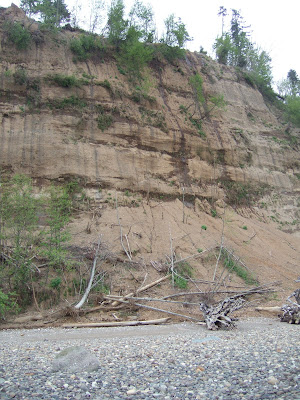I came across this bit of policy spin effort by ExxonMobil (disclosure - I have some stock in the company). This cartoon graphic showing how small the hydrofracturing footprint is compared to other energy foot prints natural-gas/surface-footprint.
I have done some research on hydrofracturing in part for work and in part as a policy matter. A recent work project was a bit of loss leader - perhaps 20 hours of research to write a few paragraphs in a report regarding a potential resource development. But some interesting stuff and plenty of hype all around for and against.
But work aside the cartoon footprint by ExxonMobil makes unconventional gas with horizontal drilling and hydrofracturing appear very benign relative to other energy sources.
The footprint issue is only one aspect of the shale gas plays and coal bed gas plays, but a recent USGS report http://pubs.usgs.gov/of/2013/1025/OFR2013_1025.pdf gives some perspective on the unconventional gas footprint.
The footprints might be small, but there are a lot of them - 9,600 Marcellus shale gas permits and get your head around this number - 49,500 non-Marcellus permits. This over just a seven year period.
Based on the number of wells and projecting from the USGS report, the footprint in Pennsylvania is on the order of 80,000 acres. But that does not count pipeline routes. A few footprint images from Pennsylvania via Google Earth:
And there are other impacts: roads from trucking, air from compressors, noise from drilling and compressors and the shear numbers of workers that surge into rural communities. The work does create a lot of wealth and a lot of energy. There is no doubt the impacts are both positive and negative. Its the impact of a lot of small but cumulative impacts.
Washington State? Not much in the way of promising shale oil or gas. Where I know there may be some, the units are rather disrupted and hence not very appealing. Our shales are not like the broad gently undulating and continuous shales in the big gas or oil areas. Where there might be some interest will be in coal bed methane as there are substantial coal beds in parts of Washington State. Some early exploration took place in Whatcom County approximately 10 years ago.
I have done some research on hydrofracturing in part for work and in part as a policy matter. A recent work project was a bit of loss leader - perhaps 20 hours of research to write a few paragraphs in a report regarding a potential resource development. But some interesting stuff and plenty of hype all around for and against.
But work aside the cartoon footprint by ExxonMobil makes unconventional gas with horizontal drilling and hydrofracturing appear very benign relative to other energy sources.
The footprint issue is only one aspect of the shale gas plays and coal bed gas plays, but a recent USGS report http://pubs.usgs.gov/of/2013/1025/OFR2013_1025.pdf gives some perspective on the unconventional gas footprint.
Unconventional gas well permits in Pennsylvania 2004 -2010 (USGS, 2011)
The footprints might be small, but there are a lot of them - 9,600 Marcellus shale gas permits and get your head around this number - 49,500 non-Marcellus permits. This over just a seven year period.
Based on the number of wells and projecting from the USGS report, the footprint in Pennsylvania is on the order of 80,000 acres. But that does not count pipeline routes. A few footprint images from Pennsylvania via Google Earth:
Washington State? Not much in the way of promising shale oil or gas. Where I know there may be some, the units are rather disrupted and hence not very appealing. Our shales are not like the broad gently undulating and continuous shales in the big gas or oil areas. Where there might be some interest will be in coal bed methane as there are substantial coal beds in parts of Washington State. Some early exploration took place in Whatcom County approximately 10 years ago.





















































